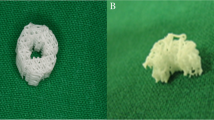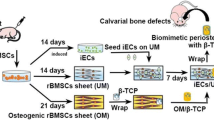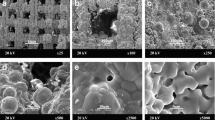Abstract
The purpose of this study was to assess and evaluate new bone formation in rabbit marginal mandibular defects using expanded bone marrow-derived osteoprogenitor cells seeded in three-dimensional scaffolds of polycaprolactone/tricalcium phosphate (PCL/TCP). Bone marrow was harvested from the rabbit ilium and rabbit bone marrow-derived osteoprogenitor cells were isolated and expanded in standard culture medium and osteogenic medium supplement. The cells were then seeded into the PCL/TCP scaffolds and the cell/scaffold constructions were implanted into prepared defects in rabbit mandibles. PCL/TCP scaffold alone and autogenous bone graft from the mandible were also implanted into the other prepared defects. The specimens were evaluated at 4 and 8 weeks after the implantation using clinical, radiographic, and histological techniques. The results of the experimental group demonstrated more newly formed bone on the surface and in the pores of the PCL/TCP scaffolds. In addition, the osteoblasts, osteocytes, and new bone trabeculae were identified throughout the defects that were implanted with the cell/scaffold constructions. The PCL/TCP alone group was filled mostly with fibrous cells particularly in the middle region with less bone formation. These results would suggest that the derived osteotoprogenitor cells have the potential to form bone tissue when seeded onto PCL/TCP scaffolds.








Similar content being viewed by others
References
Li Z, Li ZB. Repair of mandible defect with tissue engineering bone in rabbits. ANZ J Surg. 2005;75:1017–21.
Sato K, Haruyama N, Shimizu Y, Hara J, Kawamura H. Osteogenesis by gradually expanding the interface between bone surface and periosteum enhanced by bone marrow stem cell administration in rabbits. Oral Surg Oral Med Oral Pathol Oral Radiol Endod. 2010;110:32–40.
Lynch SE. Introduction. In: Lyneh SE, Marx RE, Nevins M, Lynch LA, editors. Tissue engineering: applications in oral and maxillofacial surgery and periodontics, 2nd edn. Chicago: Quintessence Publishing; 2006. p. 11–5.
Salgado AJ, Oliveira JT, Pedro AJ, Reis RL. Adult stem cells in bone and cartilage tissue engineering. Curr Stem Cell Res Ther. 2006;1:345–64.
Cao T, Ho KH, Teoh SH. Scaffold design and in vitro study of osteochondral coculture in a three-dimensional porous polycaprolactone scaffold fabricated by fused deposition modeling. Tissue Eng. 2003;9 Suppl 1:S103–12.
Hutmacher DW. Scaffolds in tissue engineering bone and cartilage. Biomaterials. 2000;21:2529–43.
Schantz JT, Hutmacher DW, Chim H, Ng KW, Lim TC, Teoh SH. Induction of ectopic bone formation by using human periosteal cells in combination with a novel scaffold technology. Cell Transplant. 2002;11:125–38.
Zein I, Hutmacher DW, Tan KC, Teoh SH. Fused deposition modeling of novel scaffold architectures for tissue engineering applications. Biomaterials. 2002;23:1169–85.
Rai B, Oest ME, Dupont KM, Ho KH, Teoh SH, Guldberg RE. Combination of platelet-rich plasma with polycaprolactone-tricalcium phosphate scaffolds for segmental bone defect repair. J Biomed Mater Res A. 2007;81:888–99.
Rai B, Ho KH, Lei Y, Si-Hoe KM, Jeremy Teo CM, Yacob KB, et al. Polycaprolactone-20% tricalcium phosphate scaffolds in combination with platelet-rich plasma for the treatment of critical-sized defects of the mandible: a pilot study. J Oral Maxillofac Surg. 2007;65:2195–205.
Lei Y, Rai B, Ho KH, Teoh SH. In vitro degradation of novel bioactive polycaprolactone--20% tricalcium phosphate composite scaffolds for bone engineering. Mater Sci Eng C. 2007;27:293–8.
Schantz JT, Teoh SH, Lim TC, Endres M, Lam CX, Hutmacher DW. Repair of calvarial defects with customized tissue-engineered bone grafts I. Evaluation of osteogenesis in a three-dimensional culture system. Tissue Eng. 2003;9 Suppl 1:S113–26.
Shao XX, Hutmacher DW, Ho ST, Goh JC, Lee EH. Evaluation of a hybrid scaffold/cell construct in repair of high-load-bearing osteochondral defects in rabbits. Biomaterials. 2006;27:1071–80.
Zhang JC, Lu HY, Lv GY, Mo AC, Yan YG, Huang C. The repair of critical-size defects with porous hydroxyapatite/polyamide nanocomposite: an experimental study in rabbit mandibles. Int J Oral Maxillofac Surg 2010;39:469–77.
Chen FH, Song L, Mauck RL, Li W-J, Tuan RS. Mesenchymal stem cells. In: Lanza R, Langer R, Vacanti J, editors. Principles of tissue engineering (Third edition). Burlington, MA: Elsevier Academic Press; 2007. p. 823–43.
Siegel MI, Mooney MP. Appropriate animal models for craniofacial biology. Cleft Palate J. 1990;27:18–25.
Djasim UM, Wolvius EB, van Neck JW, Weinans H, van der Wal KG. Recommendations for optimal distraction protocols for various animal models on the basis of a systematic review of the literature. Int J Oral Maxillofac Surg. 2007;36:877–83.
Rai B, Teoh SH, Ho KH, Hutmacher DW, Cao T, Chen F, et al. The effect of rhBMP-2 on canine osteoblasts seeded onto 3D bioactive polycaprolactone scaffolds. Biomaterials. 2004;25:5499–506.
Rai B, Teoh SH, Ho KH. An in vitro evaluation of PCL-TCP composites as delivery systems for platelet-rich plasma. J Control Release. 2005;107:330–42.
Rai B, Ho KH, Lei Y, Si-Hoe KM, Jeremy Teo CM, Yacob KB, et al. Polycaprolactone-20% tricalcium phosphate scaffolds in combination with platelet-rich plasma for the treatment of critical-sized defect of the mandible: a pilot study. J Oral Maxillofac Surg. 2007;65:2195–205.
Rai B, Teoh SH, Hutmacher DW, Cao T, Ho KM. Novel PCL-based honeycomb scaffolds as drug delivery systems for rhBMP-2. Biomaterials. 2005;26:3739–48.
Rai B, Lin JT, Lim ZX, Guldberg RE, Hutmacher DW, Cool SM. Differences between in vitro viability and differentiation and in vivo bone-forming efficacy of human mesenchymal stem cells cultured on PCL-TCP scaffolds. Biomaterials. 2010;31:7960–70.
Author information
Authors and Affiliations
Corresponding author
Ethics declarations
Conflict of interest
The authors declare that they have no conflict of interest.
Rights and permissions
About this article
Cite this article
Nuntanaranont, T., Promboot, T. & Sutapreyasri, S. Effect of expanded bone marrow-derived osteoprogenitor cells seeded into polycaprolactone/tricalcium phosphate scaffolds in new bone regeneration of rabbit mandibular defects. J Mater Sci: Mater Med 29, 24 (2018). https://doi.org/10.1007/s10856-018-6030-z
Received:
Accepted:
Published:
DOI: https://doi.org/10.1007/s10856-018-6030-z




